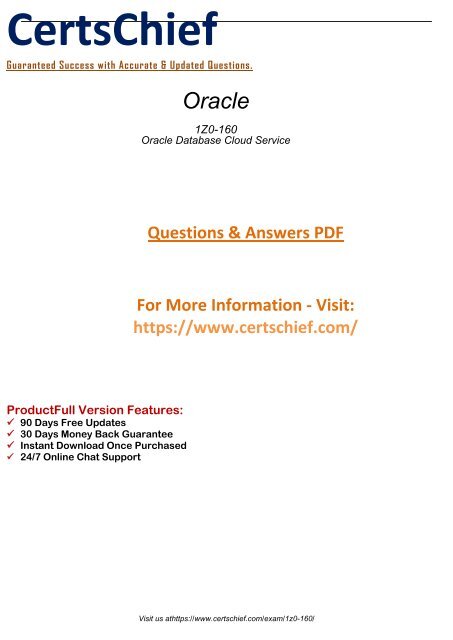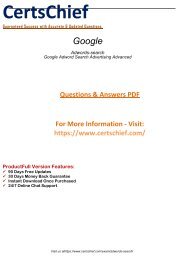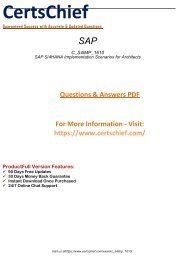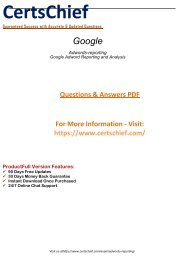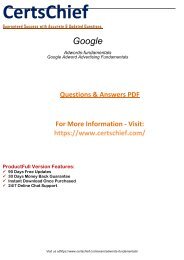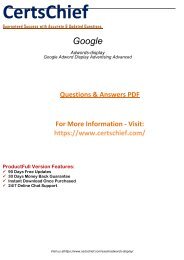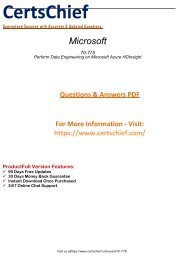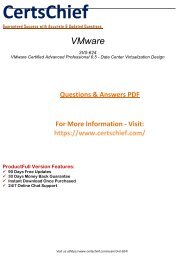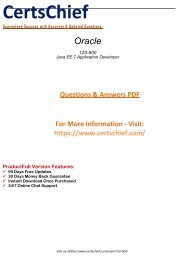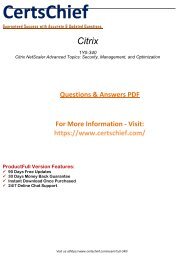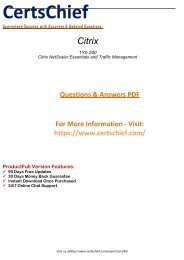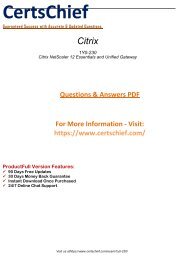1Z0-160
Study units and arrangement materials gave by us to 1Z0-160 Test are approved by the experts and industry specialists. You can without much of a stretch breeze through your accreditation test with our cerebrum dumps and PDF test questions. SpecialistI wish to offer you 20% discount on your purchase. Please use discount voucher “20off2018” on your purchase For more information please visit here: https://www.certschief.com/exam/1Z0-160/
Study units and arrangement materials gave by us to 1Z0-160 Test are approved by the experts and industry specialists. You can without much of a stretch breeze through your accreditation test with our cerebrum dumps and PDF test questions. SpecialistI wish to offer you 20% discount on your purchase. Please use discount voucher “20off2018” on your purchase For more information please visit here: https://www.certschief.com/exam/1Z0-160/
You also want an ePaper? Increase the reach of your titles
YUMPU automatically turns print PDFs into web optimized ePapers that Google loves.
CertsChief<br />
Guaranteed Success with Accurate & Updated Questions.<br />
Oracle<br />
<strong>1Z0</strong>-<strong>160</strong><br />
Oracle Database Cloud Service<br />
Questions & Answers PDF<br />
For More Information - Visit:<br />
https://www.certschief.com/<br />
ProductFull Version Features:<br />
90 Days Free Updates<br />
30 Days Money Back Guarantee<br />
Instant Download Once Purchased<br />
24/7 Online Chat Support<br />
Visit us athttps://www.certschief.com/exam/1z0-<strong>160</strong>/
Question: 1<br />
You want all your colleagues to be able to access the compute node associated with an Oracle Database<br />
Cloud – Database Deployment instance. You want them to do so by using a custom host name rather<br />
than an IP address regardless of the client machine (personal or provided by the company) that they use<br />
for the access.<br />
How would you enable this access?<br />
A. Configure the Advanced Security Option (ASO).<br />
B. Enable secure access to the Database Deployment compute node and database instance from remote<br />
hosts by using SSH.<br />
C. Contact the administrator of your company’s intranet DNS and request a custom DNS record for the<br />
compute node’s public IP address.<br />
D. Edit the machine’s /etc/hosts file.<br />
E. Resolve your domain name to the IP address of the Database Deployment compute node by using the<br />
third-party domain registration vendor console.<br />
Answer: C<br />
Explanation:<br />
You can associate a custom host name or domain name to the public IP address of a compute node<br />
associated with your Oracle Database Cloud Service environment.<br />
To associate a custom host name to the public IP address of a compute node, contact the administrator<br />
of your DNS (Domain Name Service) and request a custom DNS record for the compute node’s public IP<br />
address. For example, if your domain is example.com and you wanted to use clouddb1 as the custom<br />
host name for a compute node, you would request a DNS record that associates clouddb1.example.com<br />
to your compute node's public IP address.<br />
References: https://docs.oracle.com/en/cloud/paas/database-dbaas-cloud/csdbi/define-custom-hostor-domain-name.html<br />
Question: 2<br />
With Oracle Database Cloud Service as the subscription type, you must configure a database for Backup<br />
and Recovery.<br />
Which two options do you have to back up your database instance?<br />
A. No backups required. You are responsible for configuring the database backups.<br />
B. Backup to cloud storage and VM block storage. Ten days worth of backups are kept, with five most<br />
recent days worth of backups available directly on VM block storage.<br />
C. Backup to Oracle Cloud Service storage volumes that is equal to five times the value that was<br />
provided in Usable Data Storage when the instance was created.<br />
D. Backup to cloud storage and VM block storage. Fourteen days worth of backups are kept, with seven<br />
most recent days worth of backups available directly on VM block storage.<br />
Visit us athttps://www.certschief.com/exam/1z0-<strong>160</strong>/
Answer: A,C<br />
Explanation:<br />
When creating a new database deployment on Oracle Database Cloud Service, you choose whether you<br />
want automatic backups to be configured for the database. Your choices are:<br />
Both Cloud Storage and Local Storage—30 days' worth of backups are kept, with the 7 most recent days'<br />
worth available directly on the compute node’s local storage.<br />
Cloud Storage Only—30 days' worth of backups are kept, with all backups on cloud storage.<br />
None—automatic backups are not configured.<br />
References: https://docs.oracle.com/en/cloud/paas/database-dbaas-cloud/csdbi/db-deployments.html<br />
Question: 3<br />
Users must be granted roles to manage Cloud services.<br />
Which three statements are true about roles and role assignment in Oracle Database Cloud Service?<br />
A. Service administrators can assign and remove roles only for users of the services that they manage.<br />
B. The DBaaS Database Administrator role permits granting the DBaaS Database Administrator or DBaaS<br />
Database Operator role to existing users.<br />
C. Identity domain administrators can assign and remove roles for users in any identity domains.<br />
D. The DBaaS Database Operator role permits the ability to scale, patch, and backup or restore service<br />
instances.<br />
E. DBaaS network administrators can grant access privileges to designated users.<br />
Answer: A,D,E<br />
Explanation:<br />
A: A Service administrator manages administrative functions related to Oracle Cloud services within an<br />
identity domain.<br />
D: The privileges given to the DBaaS Database Administrator role include:<br />
Can scale, patch, and back up or restore database deployments<br />
Question: 4<br />
Which users are created and can be used for database and host management of your DBaaS database<br />
servers?<br />
A. root, opc and oracle users<br />
B. root, oracle and cloud users<br />
C. root and oracle users<br />
D. opc and oracle users<br />
E. cloud and oracle users<br />
Visit us athttps://www.certschief.com/exam/1z0-<strong>160</strong>/
Answer: D<br />
Explanation:<br />
Linux user accounts that are provisioned on an Oracle Database Cloud Service deployment that hosts an<br />
Oracle Real Application Clusters (Oracle RAC) database:<br />
* opc<br />
The system administrator account you use to connect to the compute node using SSH. This user can use<br />
the sudo command to perform operations that require root-user access.<br />
* oracle<br />
The Oracle Database administrator account you use to access the system and perform non-root<br />
database administration tasks.<br />
* grid<br />
The Oracle Grid Infrastructure administrator account you use to perform ASM, ACFS, and clusterware<br />
administration tasks.<br />
* root<br />
The root administrator for the system. You do not have direct access to this account. To perform<br />
operations that require root-user access, use the sudo command as the opc user.<br />
References: https://docs.oracle.com/en/cloud/paas/database-dbaas-cloud/csdbi/linux-user-accountsrac.html<br />
Question: 5<br />
Which two situations require that your Database Deployment be scaled up?<br />
A. The Database Deployment instance is maxed out on semaphore sets.<br />
B. The database instance has reached the limit in the license_max_sessions database parameter.<br />
C. The Database Deployment is maxed out on CPU.<br />
D. The database instance is out of space in the sysaux and system tablespaces.<br />
E. The Database Deployment is maxed out on storage.<br />
F. The Database Deployment is maxed out on semaphores.<br />
Answer: C,E<br />
Explanation:<br />
Existing DBCS instances may scale up to bigger shapes in OCPU, Memory and Storage for vertical scaling.<br />
For horizontal scaling, DBCS provides RAC with the Extreme Performance option currently allowing<br />
applications to scale up to 2 nodes, each with a max of 16 OCPU shapes.<br />
Note: An Oracle CPU (OCPU) provides CPU capacity equivalent of one physical core of an Intel Xeon<br />
processor with hyper threading enabled. Each OCPU corresponds to two hardware execution threads,<br />
known as vCPUs.<br />
References: https://cloud.oracle.com/opc/database/faq<br />
Question: 6<br />
Visit us athttps://www.certschief.com/exam/1z0-<strong>160</strong>/
How would you enable a port persistently to keep communication always open through that port?<br />
A. To enable a port persistently, you must contact your DBaaS support team to update the port<br />
specifications for use.<br />
B. You can use server certificates to map a server’s identity to enable persistent connection through a<br />
port to DBaaS instances.<br />
C. All ports that are available in DBaaS servers must use an SSH tunnel and cannot be enabled<br />
persistently.<br />
D. To enable a port persistently, you would require access to the Compute Cloud Service Console to<br />
open the ports to a set of IP addresses.<br />
Question: 7<br />
Answer: A<br />
dbaascli is a command-line interface for managing a database instance on cloud.<br />
Which two functions can you manage with dbaascli?<br />
A. running health checks on your database<br />
B. creating users in the database instance<br />
C. restoring from the most recent backup<br />
D. creating a database instance<br />
E. applying a patch<br />
Answer: C,E<br />
Explanation:<br />
The dbaascli utility is provided on Oracle Database Cloud Service deployments to perform a variety of<br />
life-cycle and administration operations.<br />
Using the dbaascli utility, you can perform operations like:<br />
* Database recovery<br />
The orec latest subcommand restores the most recent backup and performs complete recovery.<br />
* Patching the database deployment<br />
The dbpatchm apply subcommand applies the patch.<br />
*Changing the password of the SYS user<br />
* Checking the status of the Oracle Data Guard configuration<br />
* Switchover and failover in an Oracle Data Guard configuration<br />
* Rotating the master encryption key<br />
References: https://docs.oracle.com/en/cloud/paas/database-dbaas-cloud/csdbi/dbaascli.html<br />
Question: 8<br />
Which statement is true about the Database Deployment and Database instances in Oracle Public<br />
Cloud?<br />
Visit us athttps://www.certschief.com/exam/1z0-<strong>160</strong>/
A. An Oracle database instance can support only one Database Deployment.<br />
B. A Database Deployment can support only one Oracle database instance.<br />
C. An Oracle database instance can support multiple Database Deployment.<br />
D. A Database Deployment runs in a pluggable database (PDB), which is contained in a multi-tenant<br />
container database (CDB).<br />
E. A Database Deployment can support multiple Oracle database instances.<br />
Answer: E<br />
Explanation:<br />
References:<br />
http://www.oracle.com/webfolder/technetwork/tutorials/obe/cloud/sscs/ProvisionDB/SOACS_prereq%<br />
20_DBCS.html<br />
Question: 9<br />
Which two statements are true about the information that you see on the Database Cloud Service page?<br />
A. It shows the date the instance was last accessed.<br />
B. It shows the number of active sessions for each instance in your domain.<br />
C. It shows the total memory for all instances in your domain.<br />
D. It lists the memory for each instance in your domain.<br />
E. It shows the name of each database instance.<br />
Answer: C,E<br />
Explanation:<br />
The Oracle Database Cloud Service Services page displays all deployments on Oracle Database Cloud<br />
Service.<br />
Use the Oracle Database Cloud Service Services page to perform the following tasks:<br />
Deleting a Database Deployment<br />
The Activity page displays activities for all Oracle Database Cloud Service deployments in your identity<br />
domain.<br />
Example:<br />
Visit us athttps://www.certschief.com/exam/1z0-<strong>160</strong>/
References:<br />
http://www.oracle.com/webfolder/technetwork/tutorials/obe/cloud/sscs/ProvisionDB/SOACS_prereq%<br />
20_DBCS.html<br />
https://docs.oracle.com/en/cloud/paas/database-dbaas-cloud/csdbi/service-console-services-page.html<br />
Question: 10<br />
Which statement is true about the Oracle software releases that are currently supported in a Database<br />
as a Service (DBaaS) instance in Oracle Public Cloud?<br />
A. All versions and releases of Oracle Database 12c are supported.<br />
B. All versions and releases of Oracle Database 11g are supported.<br />
C. Oracle Database 11g Release 2 is supported.<br />
D. Oracle Database 12c is supported but only for single container databases.<br />
Explanation:<br />
11g Release 2 and 12c Release 1 (and 2) are supported.<br />
Answer: C<br />
Visit us athttps://www.certschief.com/exam/1z0-<strong>160</strong>/
References:<br />
http://www.oracle.com/webfolder/technetwork/tutorials/obe/cloud/dbaas/obe_dbaas_creating_an_in<br />
stance/obe_dbaas_creating_an_instance.html<br />
Visit us athttps://www.certschief.com/exam/1z0-<strong>160</strong>/
Powered by TCPDF (www.tcpdf.org)<br />
For More Information - Visit:<br />
https://www.certschief.com/<br />
20% Discount Coupon Code:<br />
20off2018<br />
Visit us athttps://www.certschief.com/exam/1z0-<strong>160</strong>/<br />
http://www.certschief.com/exam/0B0-104/<br />
Page | 1


